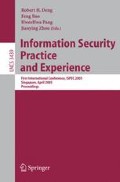Abstract
In this paper we present, by solving a variant of the guessing secrets problem defined by Chung, Graham and Leighton [3], a sequential traitor tracing scheme equipped with an efficient identification algorithm. Sequential traitor tracing schemes are used to detect piracy in multimedia content broadcast systems, where the traitors illegally rebroadcast the content they receive to unauthorized users.
Access this chapter
Tax calculation will be finalised at checkout
Purchases are for personal use only
Preview
Unable to display preview. Download preview PDF.
References
Alon, N., Guruswami, V., Kaufman, T., Sudan, M.: Guessing secrets efficiently via list decoding. In: ACM, SODA 2002, pp. 254–262 (2002)
Chor, B., Fiat, A., Naor, M.: Tracing traitors. In: Desmedt, Y.G. (ed.) CRYPTO 1994. LNCS, vol. 839, pp. 480–491. Springer, Heidelberg (1994)
Chung, F., Graham, R., Leighton, T.: Guessing secrets. The Electronic Journal of Combinatorics 8(1) (2001)
I’ve got a secret. A classic ’50’s and ’60’s television gameshow. See, http://www.timvp.com/ivegotse.html
Hollmann, H.D.L., van Lint, J.H., Linnartz, J.P., Tolhuizen, L.M.G.M.: On codes with the Identifiable Parent Property. J. Comb. Theory 82(2), 121–133 (1998)
Koetter, R., Vardy, A.: Algebraic soft-decision decoding of Reed-Solomon codes. In: ISIT 2000 (2000)
Safavi-Naini, R., Wang, Y.: Sequential traitor tracing. IEEE Trans. Inform. Theory 49(5), 1319–1326 (2003)
Staddon, J.N., Stinson, D.R., Wei, R.: Combinatorial properties of frameproof and traceability codes. IEEE Trans. Inform. Theory 47(3), 1042–1049 (2001)
Trung, T.V., Martirosyan, S.: New constructions for ipp codes. In: Proc. IEEE International Symposium on Information Theory, ISIT 2003, p. 255 (2003)
Author information
Authors and Affiliations
Editor information
Editors and Affiliations
Rights and permissions
Copyright information
© 2005 Springer-Verlag Berlin Heidelberg
About this paper
Cite this paper
Fernandez, M., Soriano, M., Cotrina, J. (2005). Tracing Traitors by Guessing Secrets. The q-Ary Case. In: Deng, R.H., Bao, F., Pang, H., Zhou, J. (eds) Information Security Practice and Experience. ISPEC 2005. Lecture Notes in Computer Science, vol 3439. Springer, Berlin, Heidelberg. https://doi.org/10.1007/978-3-540-31979-5_6
Download citation
DOI: https://doi.org/10.1007/978-3-540-31979-5_6
Publisher Name: Springer, Berlin, Heidelberg
Print ISBN: 978-3-540-25584-0
Online ISBN: 978-3-540-31979-5
eBook Packages: Computer ScienceComputer Science (R0)

